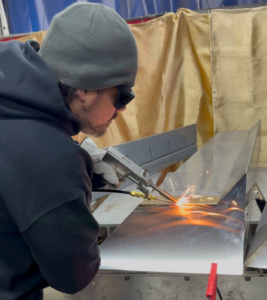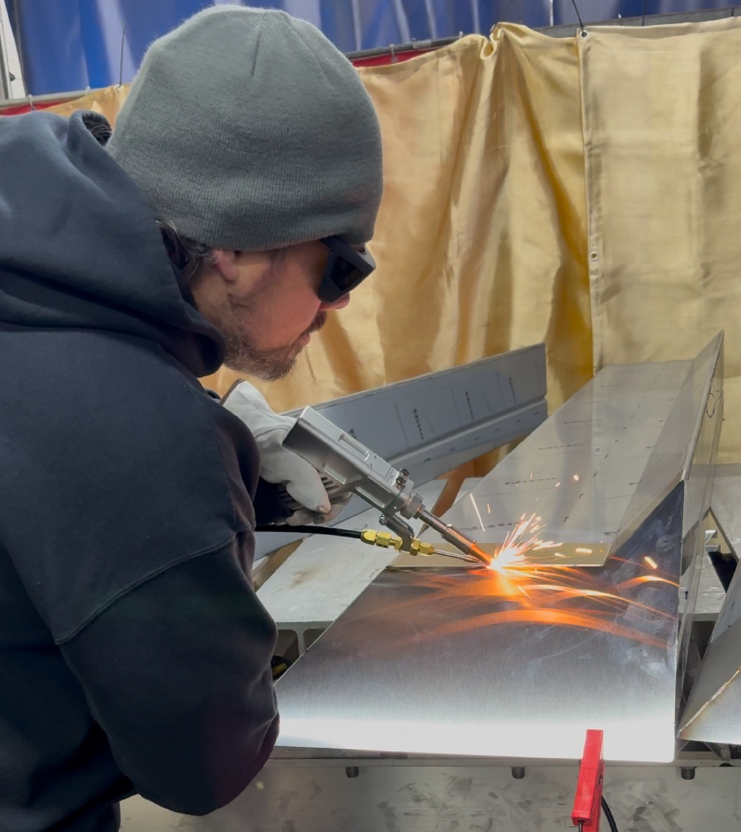In the world of fabrication and metalworking, precision and efficiency are paramount. Among the array of modern techniques available, laser welding has emerged as a leading solution for joining materials with unmatched accuracy and quality. Laser welding continues to prove its worth as a reliable, high-quality process. M.J. Nester recently began using this innovative technology, setting ourselves apart from leading competitors in the fabrication industry. But what exactly is laser welding, and why has it become the future for high quality welding?
What Is Laser Welding?
Laser welding is a process where a high-powered laser beam is used to melt and fuse materials, typically metals, at the joint area. The heat generated by the laser melts the material, which then cools and solidifies forming a strong bond. The laser is directed with great precision, allowing for fine control over the weld size, depth, and overall quality of the joint.
Unlike traditional welding methods that require filler material or external heat sources like arc or gas, laser welding is a non-contact process. This means that there is less risk of contamination and distortion in the workpiece, making it ideal for delicate or high-precision applications.
Key Benefits of Laser Welding
- Precision and Accuracy
Laser welding provides incredibly accurate control over the heat input, which minimizes the risk of damaging the surrounding material. This is particularly beneficial for industries that require high precision, such as electronics or medical device manufacturing. With the laser, it’s possible to weld fine, small parts without affecting the overall integrity of the workpiece. - Minimal Heat-Affected Zone (HAZ)
A smaller heat-affected zone means less distortion, warping, and potential changes to the material properties. Traditional welding methods often result in larger heat-affected areas that can weaken the material or cause it to deform. Laser welding’s focused heat is particularly useful when working with thin materials or components that require a high level of structural integrity. - Minimal Post-Weld Cleanup
Thanks to the focused nature of the laser beam, laser welding produces neat and clean welds with less spatter or oxidation. Providing higher quality welds and final products. - Versatility
Laser welding is versatile in terms of the types of materials it can handle. Whether it’s stainless steel, aluminum, or titanium, laser welding can accommodate a wide range of materials. The technology is also flexible enough to weld dissimilar metals, which tend to be more difficult with conventional welding techniques.
Applications for Laser Welding
Laser welding has proven to be a valuable tool in various sectors. Recently M.J. Nester used their laser welder for metal curbing which is to be installed on-site. The team was able to provide higher quality curbing than is available with traditional welding techniques.
Challenges of Laser Welding
While laser welding offers numerous advantages, it’s not without its challenges. The initial investment in equipment can be quite high, making it less accessible for small-scale operations. Additionally, the technique requires a high level of expertise, both in terms of handling the equipment and in understanding how to optimize the process for different materials.
Laser welding also requires a stable and clean working environment, as factors like dust, humidity, and surface contamination can negatively impact the quality of the weld. As with all precision technologies, maintenance of the equipment is crucial to ensure long-term performance.
M.J. Nester is counter-acting these challenges by building a room in our new building that will be dedicated to laser welding. Not only will this allow the team to achieve optimal performance out of this machine, but it will allow for a safer work environment for all of our team members.
Conclusion
Laser welding stands as one of the most advanced and efficient techniques in modern manufacturing. Offering unmatched precision, speed, and versatility, it continues to revolutionize industries.
Contact M.J. Nester to hear more about the capabilities of our Laser Welder.

